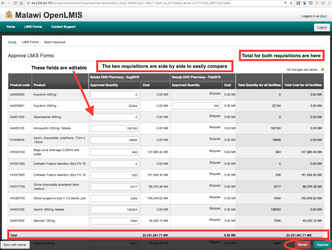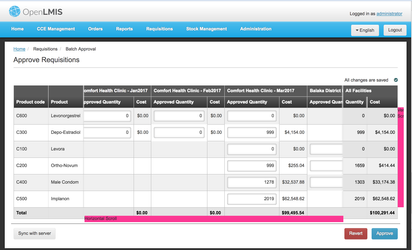Last Meeting Notes: August 29 2017
AGENDA
| Item | Lead (Time) | Notes | ||||||||||
|---|---|---|---|---|---|---|---|---|---|---|---|---|
Software Development Update
| Mary Jo Kochendorfer (Deactivated) (10 minutes) |
| ||||||||||
OpenHIE Supply Chain Sub-committee Meeting
| Mary Jo Kochendorfer (Deactivated) (5 minutes) | OpenHIE pulling together agenda. Participants attending may include Chai, JSI, VR, UNICEF, USAID?, Gates? Tenly talked with Paul and Jennifer yesterday. | ||||||||||
Gap Analysis Update
| Mary Jo Kochendorfer (Deactivated) (5 minutes) | Thanks to all who gave priorities - most all are there. Offline - Mary Jo and Carl will work on weighting priorities (global vs in country) and will bring this back to PC via email. These will be presented to governance committee next week. | ||||||||||
Performance Deep Dive
| Josh Zamor (20 minutes) | Any specific topics? Performance has been an issue in Malawi - would like to see approaches/options to 1. track performance from server and client end 2. approaches to improving performance
Touch base on how offline is done and how this contributes to performance improvement Parambir: Is there a plan that we can have a tool or methodology to monitor what’s going on at the client end to gather metrics? Testing extensively does help, but we need to gather data on what went wrong on the client end. Josh: Nick and I have had discussions about how to track what’s happening in the browser. One of the things we do have, Malawi has, Google analytics. You should be able to go to your google analytics page to see what the user has experienced. Parambir: Does that capture network interruptions, or if there was something wrong in the browser? Josh: We have to figure out what kind of data we send, and how the UI is going to collect that data when its running. We have been talking about that, and we are going to have to be mindful on how we build it. So we don’t send so much information that it won’t go over the network we are trying to report on. Nick: We want to identify pages that are taking the most network time to load. We don’t have the details to parse what is happening yet. Parambir: I’m trying to understand where we are at. As part of the testing, we should include something that we can gather data and review. It should be about gathering data in a real-time environment. Getting the telemetry data, at least that would really help us. If we need a small app at the client end, that would help. As long as we know which parameters we need to collect – not collecting personal data. Josh: That would be a great place for the PC to think about which metrics you need to see. This helps us analyze whether we buy vs build. From the network perspective we have Scalyr. We can see how the server is doing. You can look at the web server to see the responses, response times from the server’s perspective. If you want to find out how specific java code is working, you can look at the log messages from the perspective of that function. So for a user request, you can see how long it took. Mary Jo: Great next steps for PC, to define what metrics we want to see to support the team in prioritizing what to focus on next for performance testing. Josh: We could put together a couple of basic questions to start collaborating. Computer hardware, viruses, networks, and getting into the guts of OpenLMIS performance. Parambir: Collecting the platform specs, browser version, etc is important. If we identify specific end users then it helps us to get to know when the pain happens. Mary Jo: I’ll chat with team and determine when to send out questions. Please do respond to email requests to help us think this through. Come prepared for the discussion so that we are bringing our best foot forward. | ||||||||||
Questions on upcoming work/features: View Requisitions page enhancements:
| Sam Im (Deactivated) (10 min) | |||||||||||
| Member updates? Upcoming travel or opportunities? | 10 minutes |
ACTION ITEMS:
- Mary Jo Kochendorfer (Deactivated) to schedule a future product committee meeting for a more indepth discussion around product performance tracking in Jenkins
- Mary Jo Kochendorfer (Deactivated) Schedule a product committee call to discuss the tools used for tracking tests on OpenLMIS
- Mary Jo Kochendorfer (Deactivated): Schedule time for PC to define what metrics we want to see, and this will support the team in prioritizing what to focus on next for performance testing.
ATTENDANCE:
Amanda BenDor (Unlicensed), Ashraf, Parambir S Gill (Unlicensed), Chris Opit (Unlicensed), Christine Lenihan, Brandon Bowersox-Johnson, Mary Jo Kochendorfer (Deactivated), Josh Zamor, Nick Reid (Deactivated), Sam Im (Deactivated), Tenly Snow (Deactivated), Dércio Duvane, Alfred Mchau
RECORDING:
Video: <insert> OpenLMIS Product Committee Meeting-20170912 1559-1.arf (download the WebEx video player here)
ADDITIONAL READING:
Does anyone have concerns with the suggested new design for batch approval view?
We are proposing a scroll bar to improve performance. The Malawi team and some other folks familiar with our UI should review this improvement. Send us an email or ping us on Slack if you see any concerns with this design.
Original look and feel:
Proposed new look and feel:
The details of the proposed new design are in the ticket:
| Jira Legacy | ||||||
|---|---|---|---|---|---|---|
|

